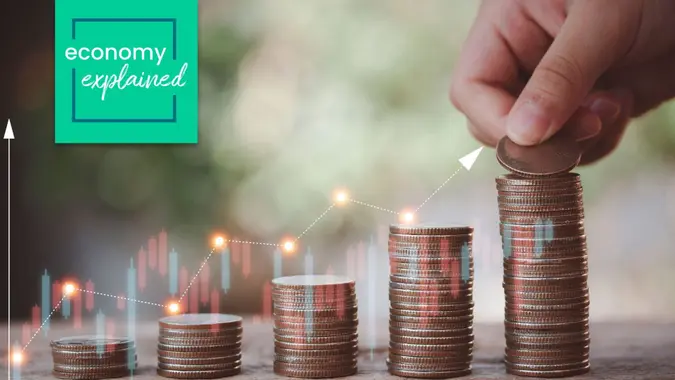How Interest Rates Impact Your Wallet and the Bigger Economic Picture

Commitment to Our Readers
GOBankingRates' editorial team is committed to bringing you unbiased reviews and information. We use data-driven methodologies to evaluate financial products and services - our reviews and ratings are not influenced by advertisers. You can read more about our editorial guidelines and our products and services review methodology.

20 Years
Helping You Live Richer

Reviewed
by Experts

Trusted by
Millions of Readers
Interest is the price you have to pay for borrowing money. The interest rate is what that price is. Lenders charge interest because they can’t simply give away money. They have to make a profit to stay in business.
So when you borrow, you have to pay back the amount of the loan plus an additional amount charged by the lender — interest — for the use of its money.
The interest rate you’ll have to pay will depend on a variety of factors. It’s important to understand those factors as well as how interest rates affect the amount you pay to borrow and how they impact the overall economy.
How Interest Rates Work
Interest rates are expressed as a percentage. If, for example, a loan has an interest rate of 5%, that means you have to pay the lender back the amount you borrow (the principal) plus 5% of the principal.
The length of time you borrow money also gets factored into the equation. Simple interest equals principal x rate x time period. So if you borrowed $1,000 at a rate of 5% for one year, the calculation would be 1,000 x .05 x 1. The interest you would pay would be $50, and the total you would repay to the lender would be $1,050.
It can get a little more complicated than this, though. Simple interest means interest is charged only on the principal. Compound interest is interest that is calculated on the principal plus the interest that has accrued. It’s important to know whether the interest on a loan is compounding and how often it’s compounding (daily, monthly, annually) because that will affect the total amount you have to pay over time.
You also should pay attention to the annual percentage rate (APR) when borrowing money. The APR includes the interest rate being charged plus any additional fees the lender is charging — so it reflects the total cost of the loan.
What Determines Interest Rates
The interest rates that lenders charge consumers are heavily influenced by rates set by the Federal Reserve: the federal funds rate, the discount rate and the reserve rate. The federal funds rate is the most influential because it’s the rate banks charge each other for overnight loans.
Many banks set their prime rate — the base interest rate they use for commercial loans and some consumer loans and lines of credit — based on the target range that the Federal Open Market Committee sets for the federal funds rate. The prime rate is just a starting point, though, as are other benchmarks banks used to set rates. Lenders consider other factors when setting interest rates:
- Creditworthiness of the borrower: Lenders will check your credit score and credit history, which will show them how responsible you are when it comes to managing credit. The more creditworthy you are, the lower your interest rate will be.
- Length and amount of the loan: Shorter and smaller loans typically come with lower interest rates than longer-term, large loans.
- Down payment amount: Certain loans such as home mortgages and auto loans typically require a down payment. Making a large down payment (such as 20% or more on a home) can help you get a lower interest rate because it signals to lenders that you’re less of a risk.
How Interest Rates Affect You
If you borrow money, it’s important to pay attention to the interest rate you have to pay. The higher the rate, the more you’ll have to pay back to the lender. That’s why it’s a good idea to avoid racking up high-interest debt, such as credit card debt. The more interest you have to pay, the less money you’ll have to pay for things you need and want.
On the flip side, a high-interest rate can be beneficial if you’re earning it on money that you have put into a savings account or that you have invested. If you’re investing for retirement, a higher rate of return will help you reach your retirement savings goal faster.
How Interest Rates Affect US Financial Markets
Interest rates not only affect what you have to pay to borrow money — they also affect the economy and the stock and bond markets. Lower interest rates tend to help the economy grow because households can borrow more money to make purchases and businesses can borrow more to expand their operations. Higher rates, on the other hand, tend to slow down economic growth.
Interest rates don’t have a direct impact on the stock market. Stock prices can rise or fall during times of rising interest rates. However, there is a direct correlation between interest rate changes and bond prices. When interest rates rise, bond yields rise and bond prices fall. When rates fall, bond prices rise.
Because interest rates affect so many aspects of the economy, they are one of the most closely watched economic indicators. You should be watching them closely, too, because they can greatly affect your personal finances.
This article is part of GOBankingRates’ ‘Economy Explained’ series to help readers navigate the complexities of our financial system.
More From GOBankingRates
- Suze Orman: 5 Social Security Facts Every Soon-To-Be Retiree Must Know
- 4 Sneaky Car Dealership Scams That Will Be Illegal in 2024
- Here's How to Add $200 to Your Wallet -- Just For Banking Like You Normally Would
- The Biggest Mistake People Make With Their Tax Refund -- And How to Avoid It
 Written by
Written by  Edited by
Edited by 

























